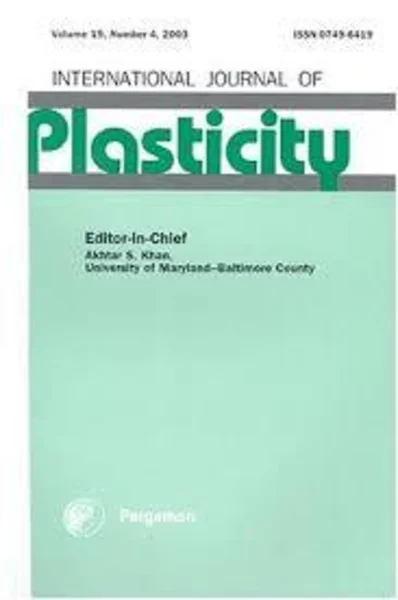-
analysis of plastic deformation in nanoscale metallic multilayers with coherent and incoherent interfaces
جزئیات بیشتر مقاله- تاریخ ارائه: 1390/01/01
- تاریخ انتشار در تی پی بین: 1390/01/01
- تعداد بازدید: 612
- تعداد پرسش و پاسخ ها: 0
- شماره تماس دبیرخانه رویداد: -
nanoscale metallic multilayered (nmm) composites possess ultra high strength (order of gpa) and high ductility, and exhibit high fatigue resistance. their mechanical behavior is governed mainly by interface properties (coherent and/or incoherent interfaces), dislocation mechanisms in small volume, and dislocation–interface interaction. in this work, we investigate these effects within a dislocation dynamics (dd) framework and analyze the mechanical behavior of two systems: (1) a bi-material system (cuni) with coherent interface and (2) a newly developed tri-material system (cuninb) composed of both coherent and incoherent interfaces. for the bi-material case we analyze the influence of networks of interfacial dislocations whose nature and distribution are commensurate with the level of relaxation and loading of the structure. misfit and pre-deposited interfacial dislocation arrays, as well as combinations of both, are studied and the dependence of strength on layer thickness is reported, along with observed dislocation mechanisms. it is shown that interfacial defect configurations significantly alter the strength and mechanical behavior of the material. furthermore, it is shown that the implementation of penetrable interfaces in dd captures the strength dependence at layer thicknesses on the order of 3–7 nm. for the tri-material case we analyze the effects of coherent and incoherent interfaces in large-scale simulations. the results show that these materials have strong strength-size dependence but are limited by the strength of the incoherent (cunb) interface which is weak in shear. the weak interface acts as a dislocation sink. this in turn induces an internal shear stress field that activates cross-slip in the adjacent cuni interlace and thus causing softening. moreover, it is shown that the yield stress of the cuninb system is controlled by the volume fraction of the nb. because nb is the most compliant of the three materials, an increase in volume fraction of nb decreases the overall yield strength of the material.
مقالات جدیدترین رویدادها
-
استفاده از تحلیل اهمیت-عملکرد در ارائه الگوی مدیریت خلاقیت سازمانی و ارائه راهکار جهت بهبود
-
بررسی تاثیر ارزش وجوه نقد مازاد بر ساختار سرمایه شرکت های پذیرفته شده در بورس اوراق بهادار تهران
-
بررسی تأثیر سطح افشای ریسک بر قرارداد بدهی شرکت های پذیرفته شده در بورس اوراق بهادار تهران
-
بررسی تأثیر رتبه بندی اعتباری مبتنی بر مدل امتیاز بازار نوظهور بر نقد شوندگی سهام با تأکید بر خصوصی سازی شرکت ها
-
تأثیر آمیخته بازاریابی پوشاک ایرانی بر تصویر ذهنی مشتری پوشاک ایرانی (هاکوپیان)
-
بررسی مقایسه ای نسبت فعالیت عضله پهن داخلی به پهن خارجی در بیماران مبتلا به جابجایی خارجی استخوان کشکک و افراد سالم
-
تحلیل حساسیت سدهای بتنی وزنی نسبت به مشخصات بتن با استقاده از آنالیز استاتیکی غیرخطی
-
سرزندگی و مطلوبیت محورهای شهری از نظر روانشناسی محیطی با توجه به ساختار و معماری آنها
-
راهکارهای ترویج فرهنگ ایرانی و اسلامی در عصر استقرار فرهنگ شبکه ای
-
بررسی خصوصیات مهندسی ماسه های بادی دشت سیستان با هدف تولید آجر ماسه ای
مقالات جدیدترین ژورنال ها
-
مدیریت و بررسی افسردگی دانش آموزان دختر مقطع متوسطه دوم در دروان کرونا در شهرستان دزفول
-
مدیریت و بررسی خرد سیاسی در اندیشه ی فردوسی در ادب ایران
-
واکاوی و مدیریت توصیفی قلمدان(جاکلیدی)ضریح در موزه آستان قدس رضوی
-
بررسی تاثیر خلاقیت، دانش و انگیزه کارکنان بر پیشنهادات نوآورانه کارکنان ( مورد مطالعه: هتل های 3 و 4 ستاره استان کرمان)
-
بررسی تاثیر کیفیت سیستم های اطلاعاتی بر تصمیم گیری موفق در شرکتهای تولیدی استان اصفهان (مورد مطالعه: مدیران شرکتهای تولیدی استان اصفهان)
-
رابطه بین فرصت طلبی مدیران و هزینه سرمایه
-
زمینه های سیاسی و اقتصادی بیداری اسلامی در تونس
-
بازشناسی دروازه های شهر شیراز
-
dynamic modeling of the effect of vehicle hybridization policy on carbon emission and energy consumption
-
competition in industries, corporate governance; and financial reporting quality




سوال خود را در مورد این مقاله مطرح نمایید :